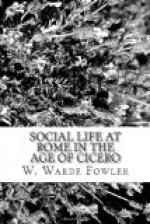The walk we have been taking has led us only through the heart of the city, in which were the public buildings, temples, basilicas, porticos, etc., of which we hear so much in Latin literature. It was on the hills which are spurs of the plain beyond, and which look down over the Forum and the Campus Martius, the Caelian, Esquiline, and Quirinal, with the hollows lying between them, and also on the Aventine by the river, that the mass of the population lived. The most ancient fortification of completed Rome, the so-called Servian wall and agger, enclosed a singularly large space, larger, we are told, than the walls of any old city in Italy;[35] it is likely that a good part of this space was long unoccupied by houses, and served to shelter the cattle of the farmers living outside, when an enemy was threatening attack. But in Cicero’s time, as to-day, all this space was covered with dwellings; and as the centre of the city came to be occupied with public buildings, erected on sites often bought from private owners, the houses were gradually pushed out along the roads beyond the walls. Exactly the same process has been going on for centuries in the University city of Oxford where the erection of colleges gradually absorbed the best sites within the old walls, so that many of the dwelling-houses are now quite two miles from the centre of the city. The fact is attested for Rome by the famous municipal law of Julius Caesar, which directs that for a mile outside the gates every resident is to look after the repair of the road in front of his own house.[36]
As a general rule, the heights in Rome were occupied by the better class of residents, and the hollows by the lower stratum of population. This was not indeed entirely so, for poor people no doubt lived on the Aventine, the Caelian, and parts of the Esquiline. But the Palatine was certainly an aristocratic quarter; the Carinae, the height looking down on the hollow where the Colosseum now stands, had many good houses, e.g. those of Pompeius and of Quintus Cicero, and we know of one man of great wealth, Atticus, who lived on the Quirinal.[37] It was in the narrow hollows leading down from these heights to the Forum, such as the Subura between Esquiline and Quirinal, and the Argiletum farther down near the Forum, that we meet in literature what we may call the working classes; the Argiletum, for example, was famous both for its booksellers and its shoemakers,[38] and the Subura is the typical street of tradesmen. And no doubt the big lodging-houses in which the lower classes dwelt were to be found in all parts of Rome, except the strictly aristocratic districts like the Palatine.




